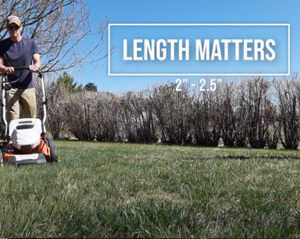Spring is in full swing in much of the country but that doesn’t mean the frigid temperatures are fully behind us yet, especially for those of us in Colorado like myself. Today I’m going to share my top 10 Spring lawn care tips to get your lawn ready for the summer months ahead. But just because YOU’RE warm enough to get started on your lawn and garden projects, that doesn’t necessarily mean that you should yet. So my first tip is to:
1. Tune up your tools
 Getting your tools ready is your first step because it makes sure everything is functioning properly and keeps you from going out and wasting money on plants that you plant too early that might get killed off by a late frost. (Guilty!) Sharpen your tools and blades, change oil and filters and do any small engine maintenance that you didn’t do in the fall.
Getting your tools ready is your first step because it makes sure everything is functioning properly and keeps you from going out and wasting money on plants that you plant too early that might get killed off by a late frost. (Guilty!) Sharpen your tools and blades, change oil and filters and do any small engine maintenance that you didn’t do in the fall.
Now If you’ve transitioned to mostly battery outdoor tools like I have, the maintenance is minimal but get your batteries charged up (Showcase the Stihl mower/tools), and get the tools cleaned up.
2. Raking, Trimming & Dethatching

You can start trimming back some overgrowth on limbs and trees in early spring and focus on removing any damaged branches that occurred over winter. However, when it comes to raking – Don’t Start too early – bees and some other beneficial insects can overwinter in leaves and debris piles. Wait until the weather is consistently in the 50’s before you clean everything up. Raking can help get sun and nutrients to the soil but don’t do it too early.
The same can be said for dethatching. Dethatching is the process of removing the thick layer of dead grass and organic material that accumulates around the base of your grass where it meets the soil. It can be beneficial to remove to allow more nutrients into the soil and to mitigate fungal growth but doing it too early in the year can actually harm your lawn’s chances of success. Instead of dethatching early, You can Use a leaf blower to help loosen up some of that matted grass and save your dethatching until later in the year.
3. Compost
 Once it’s warm enough to rake, all the materials you’re raked up from your lawn make great compost to get started for your garden. The dead leaves and small twigs make great additions to your food scraps and waste from the kitchen which will turn into valuable nutrients for your garden.
Once it’s warm enough to rake, all the materials you’re raked up from your lawn make great compost to get started for your garden. The dead leaves and small twigs make great additions to your food scraps and waste from the kitchen which will turn into valuable nutrients for your garden.
I picked up a 50 gallon Compost Tumbler from Northern Tool which is pretty easy to assemble and is easy on your back because it’s elevated and on wheels so it’s easy to move around.
4. Mowing and mulching
 If you don’t want to rake up all those annoying leaves, cutting your lawn at around 2 – 2.5” in mid spring can actually add some nutrients to the soil and help fertilize your lawn. Don’t cut it too short early in the year as it can shock the grass before it’s fully awoken from it’s dormant state.
If you don’t want to rake up all those annoying leaves, cutting your lawn at around 2 – 2.5” in mid spring can actually add some nutrients to the soil and help fertilize your lawn. Don’t cut it too short early in the year as it can shock the grass before it’s fully awoken from it’s dormant state.
5. Check Your Soil Temperature and/or Do a Soil Test
 Before you move onto any other steps it’s best to make sure your soil is ready to handle any seeding or fertilizer. Use a thermometer to check soil temperature and make sure your soil is consistently in the 50 degree range. If you fertilize your soil too early, you risk wasting money because the soil isn’t capable of handling the nutrients until it warms up. High nitrogen fertilizers too early in the season can cause more damage than good.
Before you move onto any other steps it’s best to make sure your soil is ready to handle any seeding or fertilizer. Use a thermometer to check soil temperature and make sure your soil is consistently in the 50 degree range. If you fertilize your soil too early, you risk wasting money because the soil isn’t capable of handling the nutrients until it warms up. High nitrogen fertilizers too early in the season can cause more damage than good.
If you’re not a gardener and don’t have a soil thermometer you can also use a long screwdriver or sharp object to check the soil. Stick the screwdriver into the soil. It should be able to reach a depth of about 6 inches into the soil relatively easily and without tremendous effort. If you’re having trouble getting the screwdriver down that far, it still may be a little early to move on to the next steps.
6. Aeration
 You can aerate in Spring if you need to and you want to jumpstart your lawn but I personally think aerating in the fall months is best. Soil temperatures should be at least 55-60 degrees before you get started. Aerating loosens up the compaction of the soil and allows water and nutrients to get into the soil, but it also provides an opportunity for weeds to germinate easily and can actually dry out your lawn more.
You can aerate in Spring if you need to and you want to jumpstart your lawn but I personally think aerating in the fall months is best. Soil temperatures should be at least 55-60 degrees before you get started. Aerating loosens up the compaction of the soil and allows water and nutrients to get into the soil, but it also provides an opportunity for weeds to germinate easily and can actually dry out your lawn more.
If your lawn was stressed out last fall, you might want to reconsider aerating in the spring and focus on some of the next things instead.
7. Overseeding & Fertilizing
 Once the soil temperatures have increased to about 60 degrees and up, now is the time to fertilize and overseed your lawn. If the soil is not warm enough to uptake the seeds or nutrients you’re throwing your money away.
Once the soil temperatures have increased to about 60 degrees and up, now is the time to fertilize and overseed your lawn. If the soil is not warm enough to uptake the seeds or nutrients you’re throwing your money away.
8. Don’t Use Weed Killers on your lawn before it’s woken from dormancy
Weed killers and crab grass blockers can actually inhibit the growth of your grass and specifically any new seed you’re trying to germinate. If you’re going to use these products, make sure you wait til late Spring once your grass has woken up and any new seed has germinated fully.
9. Try Not to Roll Your Lawn in the Spring Unless you have to
Rolling your lawn Compresses it and Makes it tough for nutrients, light, and water to get to your soil. It’s not uncommon for there to be high and low spots in your lawn that occur over winter, but the best time to roll your lawn is in the fall months when it is soft, full of nutrients, and ready to go into dormancy over the winter months.
10. Consider Going Drought Tolerant
 If you’re continually battling to get the results you want from your lawn year-after-year, it might be time to consider doing some lawn alternatives to make your life easier and cheaper. There are a ton of options out there including synthetic turf which I’ve previously done a video on that I’ll leave a link to, as well as xeriscaping, and adding native plants and grasses to your lawn.
If you’re continually battling to get the results you want from your lawn year-after-year, it might be time to consider doing some lawn alternatives to make your life easier and cheaper. There are a ton of options out there including synthetic turf which I’ve previously done a video on that I’ll leave a link to, as well as xeriscaping, and adding native plants and grasses to your lawn.
Thanks for checking out this article! I hope it helps you get your lawn ready for the warm summer days ahead! If you enjoyed this article, here are a few more you might like.










